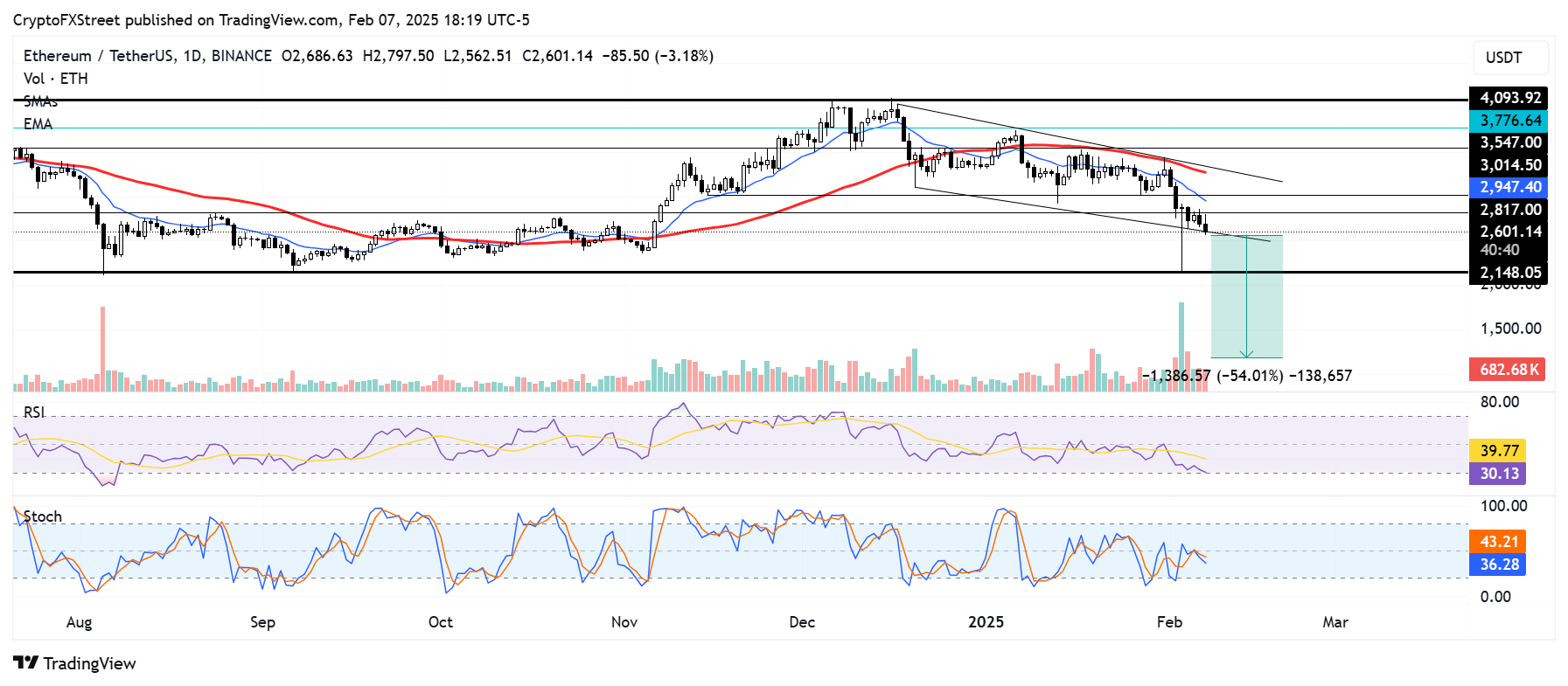Ethereum Price Forecast: ETH could hit $1,200 as Trump announces plans for reciprocal tariffs next week
Ethereum price today: $2,590
- Ethereum bears lead the market as President Trump announces plans for reciprocal tariffs on several countries next week.
- ETH's decline mirrors that of the S&P 500, underscoring crypto's rising correlation with the US stock market.
- Ethereum could decline to $1,200 if it breaks a descending channel's lower boundary line and the $2,150 support level fails.
Ethereum declined 4% on Friday following United States (US) President Donald Trump's plan to announce reciprocal tariffs on several countries next week. The move increased global trade war tensions, which has heavily weighed on the crypto market in the past week.
Ethereum faces potential sell pressure if Trump goes ahead with reciprocal tariffs
In a meeting with Japanese Prime Minister Shigeru Ishiba, President Trump highlighted that the US would impose similar tariffs that other countries place on US goods, according to Reuters.
"I'll be announcing that next week, reciprocal trade, so that we're treated evenly with other countries," said Trump.
The crypto market reacted negatively to the news, with the total market capitalization dropping over 3%. Ethereum led the losses among top cryptos, shedding over 4% of its value.
A similar decline was visible in the traditional stock market, with the S&P 500 dropping by 75 points after the announcement. This underscores the growing positive correlation between cryptocurrencies and the US stock market.
The tensions of a global trade war date back to President Trump's announcement of tariffs on Mexico, Canada and China last Friday.
Both crypto and stocks plunged sharply when the market opened on Monday. Ethereum dropped nearly 30% before seeing a quick recovery after Trump reached a resolution with Mexico and Canada to pause the intended tariffs.
If Trump moves ahead with the reciprocal tariff plan next week, it could increase bearish sentiment in the crypto market, with Ethereum potentially being heavily affected, as it had shown in the past few days.
Meanwhile, Ethereum ETFs have outperformed Bitcoin ETFs in the past week following increased buying pressure from BlackRock. BTC ETFs have seen just $32.5 million in net inflows since the beginning of the week, whereas ETH ETFs have recorded over $420 million in the same period, per Coinglass data.
Ethereum Price Forecast: ETH could decline to $1,200 if it breaks a descending channel support
Ethereum saw $65.43 million in futures liquidations in the past 24 hours, per Coinglass data. The total amount of long and short liquidations accounted for $48.28 million and $17.15 million, respectively.
On the daily chart, Ethereum is testing the lower boundary line of a descending channel after seeing a rejection near the $2,817 level. A high volume close below this channel could send ETH toward the $1,200 level if the support level near $2,150 fails.

ETH/USDT daily chart
On the upside, ETH could rally to test the descending channel's upper boundary resistance line if it bounces off the lower boundary support line. A breakout above the channel could spark an ETH rally to $4,500.
Meanwhile, the rectangular channel between $2,817 and $2,150 could prove crucial as ETH moved range-bound in this zone between early August and early November. If ETH continues seeing a rejection near $2,817, it could likely pull off a similar consolidation move.
The Relative Strength Index (RSI) and Stochastic Oscillator (Stoch) momentum indicators are below their neutral levels, indicating dominant bearish momentum.
Ethereum FAQs
Ethereum is a decentralized open-source blockchain with smart contracts functionality. Its native currency Ether (ETH), is the second-largest cryptocurrency and number one altcoin by market capitalization. The Ethereum network is tailored for building crypto solutions like decentralized finance (DeFi), GameFi, non-fungible tokens (NFTs), decentralized autonomous organizations (DAOs), etc.
Ethereum is a public decentralized blockchain technology, where developers can build and deploy applications that function without the need for a central authority. To make this easier, the network leverages the Solidity programming language and Ethereum virtual machine which helps developers create and launch applications with smart contract functionality.
Smart contracts are publicly verifiable codes that automates agreements between two or more parties. Basically, these codes self-execute encoded actions when predetermined conditions are met.
Staking is a process of earning yield on your idle crypto assets by locking them in a crypto protocol for a specified duration as a means of contributing to its security. Ethereum transitioned from a Proof-of-Work (PoW) to a Proof-of-Stake (PoS) consensus mechanism on September 15, 2022, in an event christened “The Merge.” The Merge was a key part of Ethereum's roadmap to achieve high-level scalability, decentralization and security while remaining sustainable. Unlike PoW, which requires the use of expensive hardware, PoS reduces the barrier of entry for validators by leveraging the use of crypto tokens as the core foundation of its consensus process.
Gas is the unit for measuring transaction fees that users pay for conducting transactions on Ethereum. During periods of network congestion, gas can be extremely high, causing validators to prioritize transactions based on their fees.

